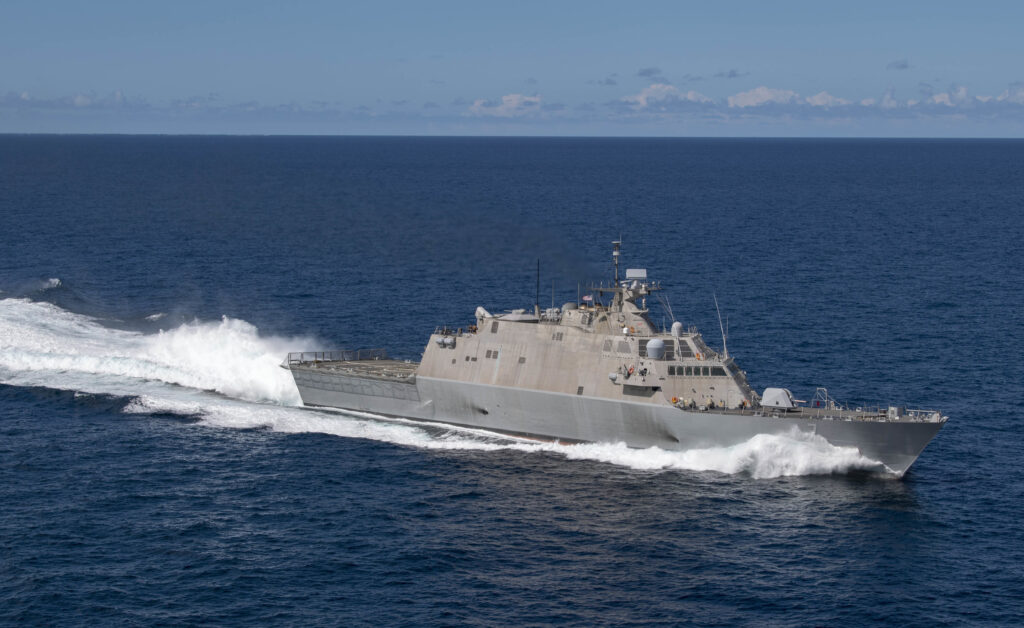
Programs such as the LCS have damaged the Pentagon’s acquisition reputation.
OPINION: The last couple of weeks have been ticker tape parade days on Wall Street, as the major defense industry players announced a surprisingly quick and lucrative recovery from the impact of COVID-19, complete with strong earnings and stunning increases in cash flow. The growth projections were rosy and supported by a potential increase in the defense budget, and the earnings calls all chimed with continuing dividends and stock buybacks to reward shareholders.
Meanwhile, back at the Defense Department where our tax dollars are being spent, major programs are still over budget and underperforming. In fact, those government programs are now $628 billion in the red, according to a new Government Accountability Office (GAO) report, which found this massive increase was due entirely to failures or other issues with the equipment or contract.
Again: $628 billion in extra taxpayer money. To put this number in perspective, that is almost equal (88%) to the entire operating budget for the Pentagon in fiscal 2020. Is this really the best use of hard-earned, American taxpayer dollars? Is this the best that we can give to our warfighters?
The short answer is no. We shouldn’t have to stand for this.
A few days ago, Adm. Mike Gilday, the Chief of Naval Operations, highlighted this very issue while giving remarks at the annual Sea Air Space Convention. He rightly pointed at two major challenges that are converging upon the Joint Force. On one side, the current budget constraints dictating every branch to learn to “do more with less.” On the other side, the growing threat posed by China is getting increasingly difficult to counter without weapons and equipment designed for the information age. The Joint Force is caught somewhere in the middle, hamstrung in part by large, traditional defense contractors who continue to leverage their domination of the government procurement process and the influence of their Congressional supporters.
“Although it’s in industry’s [financial] best interest building the ships that you want to build, lagging on repairs to ships and submarines, lobbying Congress to buy aircraft that we don’t need, that are excess to needs — it’s not helpful,” Gilday said, before pointing out that the GAO study found that 11 programs in 13 years were more expensive than planned or behind schedule. “That’s an example of … unacceptable outcomes that we cannot live with in this decade,” he said. “We can’t keep going down this path.”
Of course, acquisition follies are a Pentagon tradition. What’s new is the exponential increase in the scale of waste. As recently as the 1990s, the largest Pentagon programs averaged in the tens or hundreds of millions. Now, they are in the billions. In addition to the spiraling costs, the schedule delays have gotten more egregious. The same GAO report states that during the same time period of increased costs, the “time required to deliver initial capabilities has increased by 30%.”
I know the heads of five companies that support the supply chains of major defense contractors. They will always bring up the fact that these defense clients are relentless on pricing and delivery performance, especially those companies that also have commercial products. How ironic is it that these same defense contractors would fail by their own purchasing standards on price, delivery and performance when comparing their track record of selling into the Defense Department.

Richard Spencer was Navy secretary from 2017 to 2019.
Let me be clear as to where this message is directed. It is not the defense industry workforce, who do yeomen’s work and are patriots one and all. This is a message for the executive management and the Board Directors of those companies contributing to the problem outlined by Adm. Gilday. Everyone understands this select group’s primary responsibility is to the shareholder, but the sustainability of your enterprise value is highly dependent upon your client.
Bottom line: this unjustifiable increase in cost and delay in schedules hurts our national security. The highly effective lobbying strategies of the primes has resulted in the inability of the Pentagon to untangle our key weapons and equipment systems from legacy items that were built for a decades-old conflict and leaves our warfighters at huge disadvantages.
Importantly, it wasn’t always like this. Back when we had multiple suppliers competing on value and performance, the Douglas A-4 Skyhawk and the SR-71 Blackbird, were both completed on time and at respective fiscal year costs of $860,000 and $34 million. They both were widely considered to be highly effective aircraft.
However, the situation in present-day looks quite different. We don’t have to dig too far into history to remember the initial performance specs and cost estimates of the F-35 aircraft. The confluence of contractors over-promising capabilities and politicians — ever-mindful of their donor dollars — led the country to spend $1 trillion for a program that is now four years behind schedule and is expected to cost taxpayers an estimated $1.7 trillion, according to the Pentagon’s Cost Assessment and Program Evaluation Office’s 2020 report. This reflects an increase of more than $150 billion since the program was re-evaluated in 2012. The list goes on: the Army’s Aerial Common Sensor (ACS) aircraft was plagued by setbacks almost from the beginning, ended up being deemed “unexecutable” after it was determined that another $900 million was needed to get the program back on track.
Now, neither the CNO nor I are saying anything that hasn’t already been said by countless others — it’s no secret that the DoD has a problem with managing costs associated with weapons acquisition. I know first-hand how frustrating procurement and equipment production can be. As Secretary of the Navy, I certainly had challenges related to equipment production. The USS Gerald R. Ford and the CH-53K contributed to an incredibly frustrating time in my career, and it left me extremely disappointed in both the acquisition process and our very own contractors. This torpid pace of delivery is negligent and simply unacceptable.
The righteous indignation of Congress was on full display, and rightly so, when they tackled the on base housing crisis in 2018 — they called the CEOs of the relevant companies and held them to account in public, forcing them to agree to a way forward. But with so much more money and mission at stake, why have they not shown the same level of outrage and public inquisition to those that are underperforming in the mission of national security? The Department needs to take many of the commercial contracting standards used for performance by the private sector and incorporate them into the contracting process.
The three service secretaries have primary ownership of this issue, and I would suggest they make it a priority to request a meeting with the CEO’s and Lead Director’s of their primary suppliers and publicly outline their requirements and expectations. I would listen to the supplier issues that restrict their ability to perform as contracted, develop a game plan to get back on course and then revisit with both with regularity providing progress with the public.
The current reality of increasing great power competition necessitates that common sense must begin to take priority over conducting business as usual. I pray we do not need a cathartic event to change these bad habits. There is too much at stake for our country, our next generation and our allies.
Richard Spencer was Secretary of the Navy from 2017-2019.
Pass a preemptive CR, deal with inflation and watch the debt limit: 3 tasks for Congress
John Ferrari and Elaine McCusker of AEI argue in this op-ed that Congress needs to act quickly to ensure American national security before getting bogged down in election season.


























